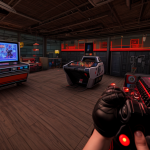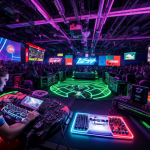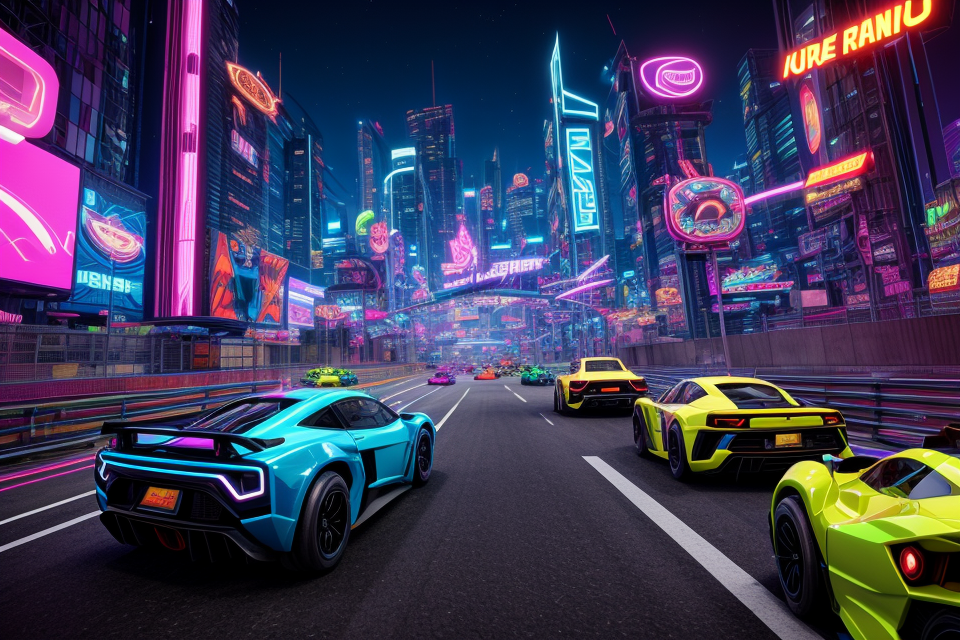Racing games have been a staple of the gaming industry for decades, with their thrilling speeds, intense competition, and adrenaline-pumping action. But what exactly defines a racing game? Is it the high-speed vehicles, the intense competition, or the sense of accomplishment when crossing the finish line? In this article, we will explore the essential elements that make a racing game truly great, and what sets them apart from other genres. Whether you’re a seasoned gamer or a newcomer to the world of racing games, this article will provide you with a deeper understanding of the art of racing games and what makes them so captivating. So buckle up and get ready to explore the world of racing games like never before!
What Defines a Racing Game?
Genres and Subgenres
Racing games are a diverse class of video games that can be further categorized into genres and subgenres based on various characteristics. These genres and subgenres help in defining the essential elements of a racing game, such as the type of vehicles, tracks, and gameplay mechanics. In this section, we will explore the different genres and subgenres of racing games and how they contribute to the overall gaming experience.
One of the primary genres of racing games is the arcade racing genre, which focuses on fast-paced, action-packed gameplay with a strong emphasis on fun and excitement. Arcade racing games often feature power-ups, weapons, and other gimmicks that add to the game’s speed and mayhem. Examples of arcade racing games include “Sega Rally” and “F-Zero.”
Another genre of racing games is the simulation genre, which aims to provide a realistic and immersive racing experience. Simulation racing games focus on accurately replicating real-world physics, vehicle handling, and performance, offering a more authentic racing experience. Examples of simulation racing games include “Gran Turismo” and “Assetto Corsa.”
In addition to these primary genres, there are several subgenres of racing games that cater to different player preferences and interests. For example, there are drifting games that emphasize the art of drifting and sliding around corners, and rally games that focus on off-road racing and navigating through various terrains.
Furthermore, racing games can also be categorized based on the type of vehicles they feature. For instance, there are games that focus on only one type of vehicle, such as “Mario Kart,” which features only karts, or “WRC,” which focuses on rally cars. There are also games that feature a variety of vehicles, such as “Need for Speed,” which includes a range of cars, bikes, and boats.
Understanding the different genres and subgenres of racing games is crucial for defining the essential elements of a racing game. Each genre and subgenre has its unique characteristics and gameplay mechanics, which contribute to the overall gaming experience. By identifying these elements, game developers can create racing games that cater to specific player preferences and interests, providing a more engaging and immersive gaming experience.
Mechanics and Gameplay
In order to fully understand the art of racing games, it is important to delve into the mechanics and gameplay that define the genre. Racing games are typically characterized by their focus on high-speed racing and competition, as well as their emphasis on skill and strategy. The mechanics and gameplay of a racing game can greatly impact the overall experience and can make or break a game’s success.
Vehicle Handling and Control
One of the most crucial elements of a racing game’s mechanics is the vehicle handling and control. This includes the way the player’s vehicle responds to various inputs, such as steering, acceleration, and braking. Realistic and responsive vehicle handling can greatly enhance the player’s sense of immersion and make the gameplay experience more enjoyable. On the other hand, poor vehicle handling can make the gameplay frustrating and unenjoyable.
Track Design and Layout
Another important aspect of a racing game’s mechanics is the design and layout of the track. The track should be designed in such a way that it provides a challenging and engaging experience for the player. It should include a variety of different elements, such as turns, straightaways, and jumps, that require the player to use different skills and strategies. Additionally, the track should be visually appealing and enhance the overall aesthetic of the game.
Race Physics and Environmental Factors
Race physics and environmental factors also play a significant role in the mechanics of a racing game. The physics engine should be realistic and accurate, taking into account factors such as gravity, friction, and aerodynamics. Environmental factors, such as weather conditions and track surface, can also greatly impact the player’s experience and require them to adapt their strategy accordingly.
Race AI and Competition
Finally, the race AI and competition aspect of a racing game’s mechanics is also crucial. The AI should be challenging yet fair, providing a competitive and engaging experience for the player. The game should also include various modes of competition, such as single-player and multiplayer, to cater to different types of players and playstyles.
In conclusion, the mechanics and gameplay of a racing game are essential elements that can greatly impact the overall experience. Vehicle handling and control, track design and layout, race physics and environmental factors, and race AI and competition are all important factors that should be carefully considered and balanced in order to create a truly immersive and enjoyable racing game.
The History of Racing Games
Early Arcade Games
The Inception of Racing Games
Racing games have been around since the early days of video gaming, with some of the earliest titles dating back to the late 1970s. The inception of racing games can be traced back to the golden age of arcade gaming, which was characterized by the widespread adoption of video games in the United States and Japan. The first racing games were simple, monochromatic affairs that relied on simple graphics and rudimentary gameplay mechanics.
Pioneering Titles
One of the earliest and most influential racing games was “Grand Prix” (1974), developed by Gary Kitchen and published by APh Technological Consulting Inc. This game featured a top-down perspective and simple 2D graphics, but offered players a thrilling sense of speed and competition. Other pioneering titles included “Speed Race” (1974) and “Indy 500” (1977), both of which were also developed by Atari.
The Rise of Arcade Racing Games
In the late 1970s and early 1980s, arcade racing games began to gain popularity as more advanced hardware became available. The rise of dedicated gaming hardware like the Namco Galaxian and Atari 2600 consoles enabled developers to create more complex and visually impressive racing games. Titles like “Gran Trak 10” (1974) and “Drag Race” (1977) featured better graphics and more sophisticated gameplay mechanics, making them early examples of the genre’s potential for growth and innovation.
The Impact of “Pole Position”
The game that would come to define the racing game genre, however, was “Pole Position” (1982), developed by Namco and published by Atari. This game featured 3D graphics and a cockpit view, offering players a more immersive and realistic racing experience. The success of “Pole Position” spawned a wave of imitators and innovations, as developers sought to push the boundaries of what was possible in the racing game genre.
The Evolution of Early Arcade Racing Games
As arcade hardware continued to advance, so too did the complexity and sophistication of arcade racing games. Titles like “Night Driver” (1980) and “Indy 800” (1989) offered players more varied tracks and better graphics, while games like “Hard Drivin'” (1989) and “Stunt Car Racer” (1989) introduced new mechanics like weapon-based combat and dynamic weather effects. By the late 1980s, arcade racing games had become a staple of the gaming landscape, paving the way for the modern racing game genre.
Evolution of Home Consoles
In the realm of racing games, home consoles have played a pivotal role in the evolution of the genre. The early days of console gaming were marked by simple, arcade-style racing games that featured minimal graphics and basic gameplay mechanics. However, as technology advanced and consoles became more sophisticated, racing games began to incorporate increasingly realistic graphics, physics engines, and immersive gameplay experiences.
One of the earliest home console racing games was “Gran Turismo” for the PlayStation, which was released in 1997. This game revolutionized the racing genre by offering a highly realistic driving experience, complete with detailed car models, accurate physics simulations, and real-world tracks. It also introduced concepts such as tuning and customization, which have since become staples of the genre.
Another significant milestone in the evolution of home console racing games was the release of “Forza Motorsport” for the Xbox in 2005. This game boasted state-of-the-art graphics and an advanced physics engine, which allowed players to experience a level of realism previously unseen in racing games. It also introduced a dynamic weather system and day-night cycles, adding an extra layer of realism to the gameplay.
As technology continued to advance, racing games became increasingly complex and sophisticated. Games like “Gear Up” and “Need for Speed” introduced features such as online multiplayer and extensive customization options, while “Assetto Corsa” and “Project Cars” focused on offering highly realistic simulations of real-world tracks and cars.
Today, home console racing games are some of the most popular and highly regarded games in the industry, with new releases constantly pushing the boundaries of what is possible in terms of graphics, physics, and gameplay. As the technology continues to evolve, it is likely that racing games will continue to be at the forefront of gaming innovation, offering players the most immersive and realistic driving experiences possible.
The Rise of Simulation Racing Games
The development of simulation racing games has played a crucial role in the evolution of the racing game genre. These games aim to provide players with a realistic and immersive experience, often incorporating advanced physics engines and accurate depictions of real-world tracks and vehicles.
One of the earliest and most influential simulation racing games was Gran Turismo, which was first released on the PlayStation in 1997. Developed by Polyphony Digital, Gran Turismo introduced a variety of real-world cars, detailed damage models, and accurate physics simulations, providing players with a unique and engaging driving experience.
In the early 2000s, simulation racing games continued to evolve, with titles such as Need for Speed: Shift and Forza Motorsport introducing advanced features like tire and suspension physics, dynamic weather conditions, and realistic damage models. These games placed a greater emphasis on realism and accuracy, catering to a growing audience of sim racing enthusiasts.
As technology advanced, so too did the capabilities of simulation racing games. Games like Assetto Corsa and Project Cars emerged, showcasing cutting-edge physics engines and detailed, accurate depictions of real-world tracks and vehicles. These games provided players with an even more immersive and realistic driving experience, further blurring the line between simulation and reality.
Today, simulation racing games continue to be popular among both casual and hardcore gamers, with ongoing development and innovation in the genre. As technology advances and new platforms emerge, it is likely that simulation racing games will continue to push the boundaries of what is possible, offering players an ever-more realistic and engaging driving experience.
Racing Game Subcultures
Competitive Racing
The Thrill of Victory
In competitive racing, the ultimate goal is to emerge victorious against fellow racers. This pursuit of victory drives the subculture, with players investing countless hours honing their skills and mastering the game’s mechanics. The exhilaration of crossing the finish line first, coupled with the cheers of fellow competitors, creates a palpable sense of accomplishment that fuels the desire to excel.
Strategic Gameplay
Competitive racing requires a deep understanding of game mechanics and strategy. Players must carefully consider factors such as vehicle performance, track conditions, and opponent tactics to gain an advantage. This level of strategic thinking sets competitive racing apart from casual play, as it demands a high degree of mental acuity and adaptability.
Online Communities
Online communities play a significant role in the competitive racing subculture. These platforms allow players to connect with like-minded individuals, share tips and strategies, and organize tournaments or events. These communities foster a sense of camaraderie and friendly rivalry, as participants strive to improve their skills and climb the leaderboards.
E-Sports Scene
Competitive racing has transitioned from the realm of hobbyists to a legitimate e-sport. Professional racing game tournaments attract massive audiences, with top players earning substantial prizes and recognition. The rise of e-sports has elevated the status of competitive racing, solidifying its place as a respected and lucrative aspect of the gaming industry.
Learning from Others
The competitive racing subculture encourages a culture of learning and growth. Players often study replays of matches, analyze rival strategies, and experiment with vehicle setups to refine their techniques. This continuous pursuit of improvement not only enhances individual skill but also contributes to the overall evolution of the game.
Social Bonds
While competitive racing fosters a spirit of healthy competition, it also cultivates strong social bonds among players. Friendships and rivalries form within online communities, leading to a rich tapestry of relationships that extend beyond the virtual world. These connections provide support, motivation, and a shared passion for the sport.
Balancing Skill and Luck
Competitive racing also challenges players to navigate the delicate balance between skill and luck. Vehicle performance, track conditions, and random events can significantly impact the outcome of a race. Successful competitors learn to manage these variables, leveraging their skill to mitigate the effects of luck and capitalize on opportunities.
Adapting to Change
The competitive racing subculture thrives on adaptation and innovation. As new games, tracks, and vehicles are introduced, players must continually adapt their strategies and techniques to stay ahead of the curve. This ever-evolving landscape keeps the subculture dynamic and engaging, as participants embrace the challenge of mastering new content.
Embrace the Community
For those seeking a thrilling and engaging experience in the world of racing games, competitive racing offers a wealth of opportunities. By embracing the community, honing skills, and mastering strategy, players can ascend to the top echelons of the competitive scene and bask in the satisfaction of victory.
Arcade Racing
Arcade racing is a subgenre of racing games that is designed to provide a more casual and accessible experience for players. Unlike simulation racing games, which prioritize realism and authenticity, arcade racing games focus on delivering fast-paced, action-packed gameplay that is easy to pick up and play.
One of the defining features of arcade racing games is their emphasis on fun and excitement over realism. These games often feature exaggerated power-ups, such as missiles and nitro boosts, that allow players to perform outlandish stunts and takedowns. Additionally, arcade racing games often feature fantastical settings and vehicles, such as futuristic racers and hovercrafts, that are not found in the real world.
Another key element of arcade racing games is their accessibility. These games are designed to be played by people of all ages and skill levels, and typically have simpler controls and more lenient difficulty curves than simulation racing games. This makes them ideal for casual gamers who want to enjoy a fun and engaging racing experience without having to invest a lot of time or effort.
Arcade racing games also tend to be more social than other types of racing games. Many arcade racing games feature multiplayer modes that allow players to compete against each other in real-time, either locally or online. This adds an extra layer of excitement and competition to the game, and makes it easier for players to connect with each other and share their experiences.
Overall, arcade racing games are a great choice for players who want a fun and exciting racing experience that is easy to pick up and play. Whether you’re a casual gamer looking for a fun diversion, or a serious gamer looking for a break from more serious racing games, arcade racing games offer a unique and enjoyable experience that is sure to please.
Sim Racing
Sim Racing, short for Simulation Racing, is a subculture within the racing game community that focuses on simulating real-world racing experiences as closely as possible. Players in this subculture are often enthusiasts of motorsports and seek a more authentic racing experience that goes beyond what traditional arcade racing games offer.
Realism and Authenticity
Sim Racing games aim to replicate the real-world physics, mechanics, and handling of vehicles, making them a popular choice for players who are interested in learning about racing techniques, improving their skills, or simply enjoying the thrill of driving high-performance cars. The level of realism in Sim Racing games varies, with some games offering a more casual experience while others are geared towards hardcore sim enthusiasts.
Virtual Racing Circuits
Sim Racing games often feature virtual representations of real-world racing circuits, allowing players to experience famous tracks from around the world. In addition to recreating these iconic circuits, Sim Racing games also offer custom-made tracks and scenarios, providing players with a wide range of challenges and experiences to enjoy.
Hardware Integration
One of the unique aspects of Sim Racing is the integration of hardware components, such as steering wheels, pedals, and shifters, to create a more immersive and realistic experience. This type of setup is commonly used by professional racing game players, as it allows for more precise control over the vehicle and enhances the overall feeling of driving.
Online Competition and Communities
Sim Racing has a strong online component, with many games offering the ability to race against other players from around the world. This has led to the formation of online communities and leagues, where players can compete in organized races, share tips and strategies, and connect with other like-minded enthusiasts.
Learning and Improvement
Sim Racing can also be a valuable tool for learning about racing techniques and improving driving skills. Many players use Sim Racing to practice and refine their skills before moving on to real-world racing, while others simply enjoy the challenge of mastering different tracks and vehicles.
In summary, Sim Racing is a subculture within the racing game community that focuses on simulating real-world racing experiences with an emphasis on realism, authenticity, and immersion. It offers a unique combination of gaming and motorsports, attracting players who are passionate about both.
Racing Game Design Principles
Realism vs. Arcade
In the world of racing games, the distinction between realism and arcade-style gameplay is a critical factor that affects the overall experience of the player. The two approaches are vastly different and have unique characteristics that appeal to various audiences.
Realism
Realism in racing games aims to simulate the authentic feeling of driving a vehicle as closely as possible. This approach prioritizes factors such as physics, mechanics, and the actual sensation of being behind the wheel. Players must pay close attention to the details of their driving, such as braking, accelerating, and cornering, to successfully navigate the game’s environment.
Realistic racing games often include features such as:
- Advanced physics engines that simulate the behavior of vehicles and their interaction with the environment.
- Detailed damage models that reflect the effects of collisions and impacts on the car’s performance.
- Authentic sound effects that reproduce the engine noises, tire screeches, and other audio cues associated with driving.
- Weather conditions and day-night cycles that affect the gameplay and visibility.
The focus on realism often leads to a more challenging and immersive experience, which appeals to players who enjoy a greater sense of accomplishment and skill development.
Arcade
On the other hand, arcade-style racing games prioritize entertainment and accessibility over realism. These games typically have a more casual approach to gameplay, with simpler mechanics and a focus on fun and excitement. Players can expect a faster pace, exaggerated power-ups, and a greater emphasis on thrilling action.
Arcade racing games often include features such as:
- Simplified physics that make it easier for players to control their vehicles and perform stunts.
- Power-ups and special abilities that give players an edge in the race, such as speed boosts or weapons.
- Vibrant, colorful environments that are more stylized and visually appealing than realistic settings.
- More forgiving collision detection that allows players to bounce back from crashes more easily.
The focus on arcade-style gameplay often leads to a more approachable and fast-paced experience, which appeals to players who prioritize fun and excitement over a challenging simulation.
Balancing Realism and Arcade Styles
In some cases, racing games strive to find a balance between realism and arcade-style gameplay, catering to a broader audience. These games often offer adjustable difficulty settings or customizable features that allow players to tailor the experience to their preferences. By combining elements of both realism and arcade-style gameplay, developers can create a more diverse and appealing game that appeals to a wider range of players.
Ultimately, the choice between realism and arcade-style gameplay depends on the desired audience and the overall vision of the game. By understanding the key differences and preferences of players, developers can craft a racing game that stands out in a competitive market and provides an engaging experience for all types of players.
Handling and Physics
Handling and physics are two crucial elements that define the essence of racing games. These elements play a pivotal role in determining the player’s experience and the overall success of the game. In this section, we will delve into the intricacies of handling and physics in racing games.
Factors Affecting Handling
- Vehicle Type: The type of vehicle being used in the game plays a significant role in determining its handling. For instance, a sports car will handle differently from a truck or a bus. The game designers must ensure that each vehicle type is accurately represented in terms of its handling characteristics.
- Road Surface: The road surface also has a significant impact on the handling of the vehicle. Factors such as the texture, grip, and friction of the road surface can affect the player’s ability to control the vehicle. The game designers must ensure that the road surface is realistically represented to provide an immersive gaming experience.
- Weather Conditions: Weather conditions such as rain, snow, and fog can also affect the handling of the vehicle. The game designers must take into account the impact of these weather conditions on the handling of the vehicle and ensure that they are accurately represented in the game.
Factors Affecting Physics
- Realism: Physics is a critical element in racing games as it determines the realism of the game. The game designers must ensure that the physics engine is accurate and realistic to provide an immersive gaming experience.
- Collision Detection: Collision detection is another critical aspect of physics in racing games. The game designers must ensure that the collision detection is accurate and realistic to provide a fair and challenging gaming experience.
- Aerodynamics: Aerodynamics plays a crucial role in racing games, particularly in high-speed races. The game designers must ensure that the aerodynamics are accurately represented to provide an immersive gaming experience.
In conclusion, handling and physics are essential elements in racing games that determine the player’s experience and the overall success of the game. The game designers must ensure that these elements are accurately represented to provide an immersive and realistic gaming experience.
Vehicle Customization
Customizing a vehicle is an essential element in racing games as it allows players to personalize their experience and make it more enjoyable. There are several key aspects to consider when implementing vehicle customization in a racing game.
Firstly, the game should provide a wide range of customization options for the player to choose from. This can include changing the color, wheels, body kits, and other aesthetic features of the vehicle. Additionally, players should be able to customize the performance of the vehicle by adjusting the engine, suspension, and other mechanical components.
Secondly, the customization options should be balanced and have a significant impact on the gameplay. For example, changing the body kit of a car may not have a noticeable effect on its performance, and thus may not be worth the effort for the player. On the other hand, changing the engine or suspension can greatly affect the car’s speed and handling, making it a valuable choice for the player.
Lastly, the customization options should be easily accessible and user-friendly. The game should provide a clear and intuitive interface for the player to customize their vehicle, and the process should be smooth and seamless.
In conclusion, vehicle customization is a crucial element in racing games as it allows players to personalize their experience and make it more enjoyable. By providing a wide range of customization options, balancing the impact of these options on gameplay, and making the customization process user-friendly, racing games can provide a more engaging and satisfying experience for the player.
The Future of Racing Games
VR and AR Technologies
Virtual Reality (VR) and Augmented Reality (AR) technologies have the potential to revolutionize the racing game genre by immersing players in realistic and engaging environments.
VR Technology
VR technology aims to create a fully immersive gaming experience by providing players with a 360-degree view of the game world. Head-mounted displays (HMDs) such as the Oculus Rift, HTC Vive, and PlayStation VR are popular VR devices that offer an immersive gaming experience. These devices track the player’s head movements and adjust the game’s perspective accordingly, creating a more realistic and engaging experience.
One of the main advantages of VR technology is its ability to create a sense of presence, which allows players to feel like they are truly inside the game world. This can lead to increased immersion and engagement, as well as a heightened sense of responsibility for the player’s actions.
AR Technology
AR technology, on the other hand, enhances the player’s view of the real world by overlaying digital elements onto it. This technology is already being used in racing games through apps like Ingress and Pokemon Go, which use GPS and other sensors to create a real-world environment with digital elements.
AR technology has the potential to make racing games more social and interactive, as players can compete against each other in real-world locations. It also offers a more accessible entry point for players who may not have access to expensive VR devices.
Both VR and AR technologies have the potential to change the way we play racing games, but they also present challenges. For example, VR technology can cause motion sickness and disorientation, while AR technology may be less engaging for players who are not physically active.
Overall, VR and AR technologies have the potential to create new and exciting experiences for racing game players, but they must be developed and implemented carefully to ensure that they are engaging, accessible, and enjoyable for all players.
eSports and Competitive Scene
As racing games continue to evolve, the competitive scene surrounding them has also grown exponentially. The rise of eSports has provided a platform for skilled players to showcase their abilities and compete in tournaments with significant prize pools.
The popularity of racing games in eSports has been fueled by their accessibility and competitive nature. Many racing games have implemented online features that allow players to compete against each other, regardless of their location. This has created a global community of players who share a passion for racing games and competition.
In addition to traditional tournaments, racing games have also embraced the concept of leagues and organized seasons. These structures provide a sense of progression and reward for dedicated players, and they have helped to foster a sense of community and rivalry within the gaming world.
The competitive scene for racing games has also led to the development of new strategies and gameplay styles. Players have discovered new ways to optimize their racing lines, use teammates to gain an advantage, and employ various tactics to outmaneuver their opponents. These innovations have made racing games more exciting and engaging for both players and spectators.
However, the competitive scene for racing games is not without its challenges. The rise of eSports has led to concerns about the impact of professional gaming on physical health, and some have questioned the sustainability of a career in eSports. Nevertheless, the competitive scene for racing games continues to grow, and many players are drawn to the excitement and camaraderie of competitive play.
As the competitive scene for racing games continues to mature, it is likely that we will see even more innovations and developments. The integration of virtual reality technology, for example, could provide a more immersive experience for players and offer new opportunities for competitive play.
Overall, the future of racing games is bright, and the competitive scene is likely to remain an important part of the gaming world for years to come. As racing games continue to evolve, players will continue to push the boundaries of what is possible, and the competitive scene will continue to thrive.
New Frontiers in Racing Game Design
Racing games have come a long way since the days of arcade classics like “Out Run” and “Daytona USA.” With the rise of advanced gaming technology and a growing demand for more realistic and immersive experiences, the future of racing games is brighter than ever. In this section, we will explore some of the new frontiers in racing game design that are set to redefine the genre.
Immersive Virtual Reality
Virtual reality (VR) technology has made significant strides in recent years, and it is poised to revolutionize the way we experience racing games. By creating a fully immersive environment, VR can transport players into the cockpit of a high-speed racecar, giving them a sense of speed and intensity that is difficult to achieve with traditional game controllers. Developers are working on creating more realistic and immersive VR experiences, which will make players feel like they are actually participating in a race.
Advanced Physics and Realism
Another area where racing game design is evolving is in the realm of physics and realism. Developers are using advanced algorithms and simulations to create more realistic environments and vehicle dynamics. This includes factors such as tire wear, weather conditions, and track surface conditions, which can all affect the performance of a racecar. As a result, players will be able to experience a more authentic racing experience that closely mirrors real-world racing.
Open-World Racing
Open-world racing games are becoming increasingly popular, offering players the freedom to explore vast environments and engage in a variety of different racing challenges. These games often feature a dynamic weather system, day-night cycles, and a wide range of vehicles to choose from. By creating a more open and exploratory experience, developers are attracting players who are looking for a more dynamic and engaging racing experience.
Multiplayer Racing
Online multiplayer racing games are another area where racing game design is evolving. With the rise of online gaming, players can now compete against each other from all over the world. Developers are working on creating more sophisticated online racing environments, which will include features such as leaderboards, matchmaking, and in-game chat. This will create a more social and competitive experience for players, which will help to keep them engaged and coming back for more.
In conclusion, the future of racing games is looking bright, with new frontiers in design that are set to redefine the genre. From immersive VR experiences to advanced physics and realism, open-world environments, and multiplayer racing, there is a lot to be excited about for fans of racing games. As technology continues to advance, we can expect to see even more innovative and immersive racing experiences in the years to come.
The Impact of Racing Games on Popular Culture
Celebration of Automotive Culture
Racing games have become an integral part of popular culture, with millions of players worldwide immersing themselves in the thrilling world of virtual motorsports. One of the primary reasons for the widespread appeal of racing games is their ability to celebrate the automotive culture, allowing players to explore the aesthetics, performance, and history of various vehicles.
- Authentic Vehicle Representation: Racing games often feature a wide range of real-life cars, accurately replicating their design, performance, and handling characteristics. This level of detail enables players to appreciate the unique aspects of each vehicle, from classic muscle cars to cutting-edge supercars. By providing players with an authentic automotive experience, racing games serve as a virtual automotive museum, showcasing the evolution of automotive design and technology.
- Customization and Upgrades: Many racing games allow players to customize their vehicles, modifying their appearance and performance. This feature encourages players to experiment with different setups, enabling them to tailor their vehicles to suit their individual driving styles. By offering customization options, racing games empower players to express their creativity and personalize their virtual rides, adding a layer of excitement and immersion to the overall experience.
- Racing Heritage and History: Racing games often pay homage to the rich history of motorsports, featuring iconic tracks, circuits, and races that have left an indelible mark on the sport. By incorporating these historic elements, racing games enable players to experience the passion and excitement of past races, connecting them to the broader automotive culture. Furthermore, many games include fictional tracks and races, allowing players to imagine new scenarios and contribute to the ever-evolving world of racing.
- Community and Competition: Racing games foster a sense of community among players, enabling them to share their experiences, compare performances, and engage in friendly competition. Online racing leagues and tournaments have become a vital aspect of the racing game experience, providing players with opportunities to test their skills against others from around the world. This competitive aspect of racing games further strengthens the connection between players and the automotive culture, as they strive to improve their driving techniques and push the limits of their virtual vehicles.
In summary, the celebration of automotive culture in racing games serves to engage players on multiple levels, offering an immersive experience that transcends mere entertainment. By accurately representing vehicles, providing customization options, honoring racing heritage, and fostering a sense of community, racing games contribute to the ongoing appreciation and promotion of the automotive culture.
Representation in Media
Racing games have become a significant part of popular culture, and their representation in media has played a significant role in this. These games have been featured in various forms of media, including movies, TV shows, and books, which has helped to further popularize them. Additionally, racing games have been used as a tool for advertising and marketing, allowing them to reach a wider audience. The inclusion of racing games in popular culture has also led to an increase in the number of people who are interested in the sport, which has had a positive impact on the industry as a whole.
The Gaming Community
The Rise of Competitive Racing Games
Racing games have become increasingly popular in the gaming community due to their competitive nature. With the advent of online gaming, players from all over the world can compete against each other in real-time, fostering a sense of community and camaraderie among gamers. This has led to the rise of eSports tournaments, where professional racing game players can showcase their skills and earn prize money.
The Evolution of Racing Game Communities
Racing game communities have evolved over time, with players forming clans, teams, and leagues to compete against each other. These communities provide a platform for players to share tips, strategies, and techniques, as well as to connect with like-minded individuals who share a passion for racing games. Online forums, social media groups, and dedicated websites have become hubs for racing game enthusiasts to discuss the latest games, trends, and updates.
The Influence of Racing Games on Gaming Culture
Racing games have had a significant impact on gaming culture, with many gamers considering them to be an essential part of the industry. The success of racing games has led to the development of other genres, such as simulation and arcade racing games, and has influenced the design and gameplay of other types of games. Racing games have also helped to popularize gaming as a form of entertainment, attracting a wider audience beyond traditional gamers and contributing to the growth of the gaming industry as a whole.
Reflecting on the Evolution of Racing Games
The world of racing games has undergone a remarkable transformation since the release of the first game in the early 1970s. Over the years, these games have evolved from simple, monochromatic pixel-based representations to stunningly realistic simulations that boast 3D graphics, realistic physics, and complex gameplay mechanics. This section will delve into the history of racing games, highlighting the key milestones that have shaped the genre into what it is today.
The Early Years: Pole Position and the Birth of Arcade Racing Games
Pole Position, released in 1982, is widely regarded as the first true arcade racing game. Developed by Namco, it introduced gamers to the concept of realistic, full-screen racetracks, where players had to navigate a variety of turns and obstacles while competing against other racers. Pole Position was a commercial success, and it set the stage for a wave of imitators that would follow in its wake.
The Emergence of Home Consoles and the Arrival of Out Run
With the rise of home consoles in the mid-1980s, racing games began to transition from the arcade to the living room. In 1986, Sega released Out Run, a groundbreaking game that introduced players to the concept of third-person perspective, fast cars, and a stunning soundtrack. Out Run was a critical and commercial success, and it paved the way for a new generation of racing games that would be released over the next decade.
The 1990s: The Rise of Sim Racing and the Emergence of Gran Turismo
The 1990s saw the emergence of sim racing games, which focused on realistic physics and authentic vehicle handling. In 1997, Polyphony Digital released Gran Turismo, a game that revolutionized the racing genre by offering players an immersive, realistic driving experience. With its focus on realistic car physics, detailed tracks, and an extensive range of vehicles, Gran Turismo quickly became a fan favorite and set the standard for all future racing games.
The 2000s: The Rise of Online Racing and the Evolution of Racing Franchises
With the advent of broadband internet, online racing games began to emerge in the early 2000s. In 2002, Electronic Arts released the first game in the Need for Speed: Underground series, which introduced players to the world of illegal street racing. This game, along with others like it, paved the way for a new generation of racing games that emphasized style, customization, and online multiplayer.
Throughout the 2000s, established racing franchises like Forza, Gran Turismo, and Need for Speed continued to evolve, adding new features, gameplay mechanics, and tracks to keep players engaged. These games became increasingly realistic, with developers striving to recreate the feel of real-world racing.
The Present Day: Virtual Reality and the Future of Racing Games
In recent years, virtual reality (VR) technology has been incorporated into racing games, allowing players to experience a truly immersive racing experience. Games like Project Cars 2 and Dirt Rally 2.0 have embraced VR, offering players the opportunity to don a headset and experience the thrill of racing from the cockpit of a car. As VR technology continues to advance, it is likely that racing games will become even more realistic, providing players with an unparalleled sense of immersion.
In conclusion, the evolution of racing games has been a remarkable journey, with each new generation introducing new technologies, gameplay mechanics, and features. From the early days of Pole Position to the present day, racing games have come a long way, and they continue to captivate players of all ages with their blend of adrenaline-fueled action and stunning realism.
The Enduring Appeal of Racing Games
The allure of racing games has endured for decades, captivating players with its blend of adrenaline-fueled excitement, realistic graphics, and engaging gameplay mechanics. The appeal of these games lies in their ability to immerse players in a world of high-speed thrills, allowing them to push the limits of their virtual vehicles as they navigate challenging tracks and compete against other racers.
One reason for the enduring appeal of racing games is their ability to cater to a wide range of players, from casual gamers to hardcore enthusiasts. With various game modes, difficulty levels, and customization options, racing games offer something for everyone, making them accessible to players of all ages and skill levels. Additionally, the competitive nature of racing games encourages players to improve their skills and push themselves to new limits, fostering a sense of achievement and satisfaction as they progress through the game.
Another factor contributing to the enduring appeal of racing games is their evolution over time. As technology has advanced, so too have the graphics and mechanics of racing games, allowing developers to create increasingly realistic and immersive experiences for players. From early arcade games to modern console titles, racing games have continued to evolve and innovate, keeping pace with technological advancements and offering players new and exciting experiences.
Furthermore, the appeal of racing games is not limited to just the virtual world. Many players enjoy the thrill of racing games because they can compete against others from around the globe, fostering a sense of community and camaraderie among players. Online leaderboards and tournaments allow players to showcase their skills and compete against others, creating a sense of competition and challenge that keeps players engaged and motivated.
In conclusion, the enduring appeal of racing games lies in their ability to provide an exciting and immersive experience for players, catering to a wide range of interests and skill levels. Whether players are seeking a casual diversion or a challenging competition, racing games continue to offer something for everyone, making them a beloved staple of the gaming world.
The Future of the Genre
- The rise of online racing games and their impact on social interaction
- The emergence of eSports and professional racing game tournaments
- The growth of online communities and in-game interactions
- The potential for new business models and revenue streams
- The integration of virtual reality and augmented reality technologies
- The enhanced immersion and realism of racing experiences
- The potential for new gameplay mechanics and storytelling opportunities
- The challenges and limitations of VR/AR technologies for racing games
- The influence of real-world motorsports on racing game design
- The importance of authenticity and realism in racing games
- The potential for new partnerships and collaborations between racing game developers and real-world motorsports organizations
- The challenges and opportunities of incorporating real-world motorsports into racing games
- The evolving trends and preferences of racing game players
- The shift towards mobile and casual racing games
- The growing interest in open-world and exploration-based racing experiences
- The importance of adapting to changing player preferences and demographics
- The potential for new technologies and platforms to shape the future of racing games
- The impact of cloud gaming and streaming services on the accessibility and scalability of racing games
- The potential for new input devices and controls for racing games
- The opportunities and challenges of developing for new platforms and technologies
FAQs
1. What is a racing game?
A racing game is a video game genre that simulates or reproduces the experience of racing cars or other vehicles. These games often involve competitive racing on various tracks, including both real-world and fictional circuits.
2. What are the essential elements of a racing game?
The essential elements of a racing game include a variety of vehicles, tracks, and competitive gameplay. The vehicles can range from real-world cars to fictional vehicles, and the tracks can range from real-world locations to imaginary environments. The competitive gameplay typically involves racing against other players or AI opponents to reach the finish line first.
3. What makes a racing game different from other genres?
Racing games differentiate themselves from other genres by their focus on fast-paced, competitive gameplay that involves driving and maneuvering vehicles. While other genres may involve driving, they typically do not focus on the competitive aspect of racing and may not include features such as realistic physics and tuning.
4. What are some popular racing game franchises?
Some popular racing game franchises include “Gran Turismo,” “Need for Speed,” “Forza,” and “Dirt.” These franchises have been around for many years and have built a loyal fan base with each new release.
5. What are some important factors to consider when evaluating a racing game?
When evaluating a racing game, it’s important to consider factors such as the game’s graphics, sound design, physics, and control scheme. A good racing game should provide a realistic and immersive driving experience that accurately simulates the feel of driving a variety of vehicles. Additionally, the game’s online features, if present, should be well-implemented and provide a smooth and fair multiplayer experience.









